Page 49 of 532
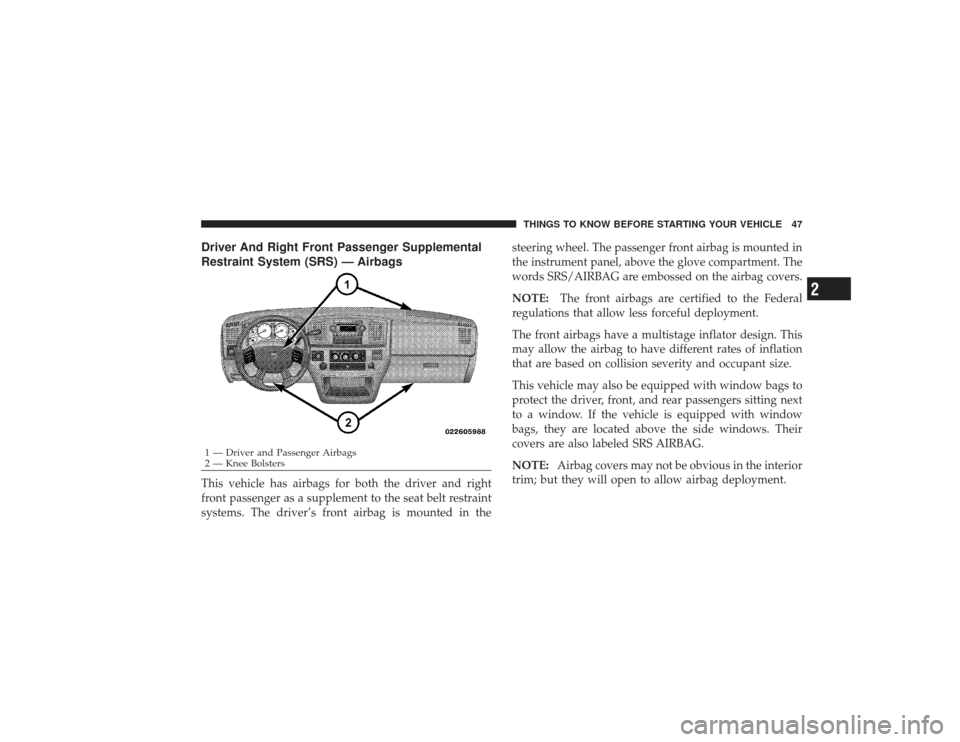
Driver And Right Front Passenger Supplemental
Restraint System (SRS) — AirbagsThis vehicle has airbags for both the driver and right
front passenger as a supplement to the seat belt restraint
systems. The driver’s front airbag is mounted in thesteering wheel. The passenger front airbag is mounted in
the instrument panel, above the glove compartment. The
words SRS/AIRBAG are embossed on the airbag covers.
NOTE:
The front airbags are certified to the Federal
regulations that allow less forceful deployment.
The front airbags have a multistage inflator design. This
may allow the airbag to have different rates of inflation
that are based on collision severity and occupant size.
This vehicle may also be equipped with window bags to
protect the driver, front, and rear passengers sitting next
to a window. If the vehicle is equipped with window
bags, they are located above the side windows. Their
covers are also labeled SRS AIRBAG.
NOTE: Airbag covers may not be obvious in the interior
trim; but they will open to allow airbag deployment.1 — Driver and Passenger Airbags
2 — Knee Bolsters THINGS TO KNOW BEFORE STARTING YOUR VEHICLE 47
2
Page 50 of 532
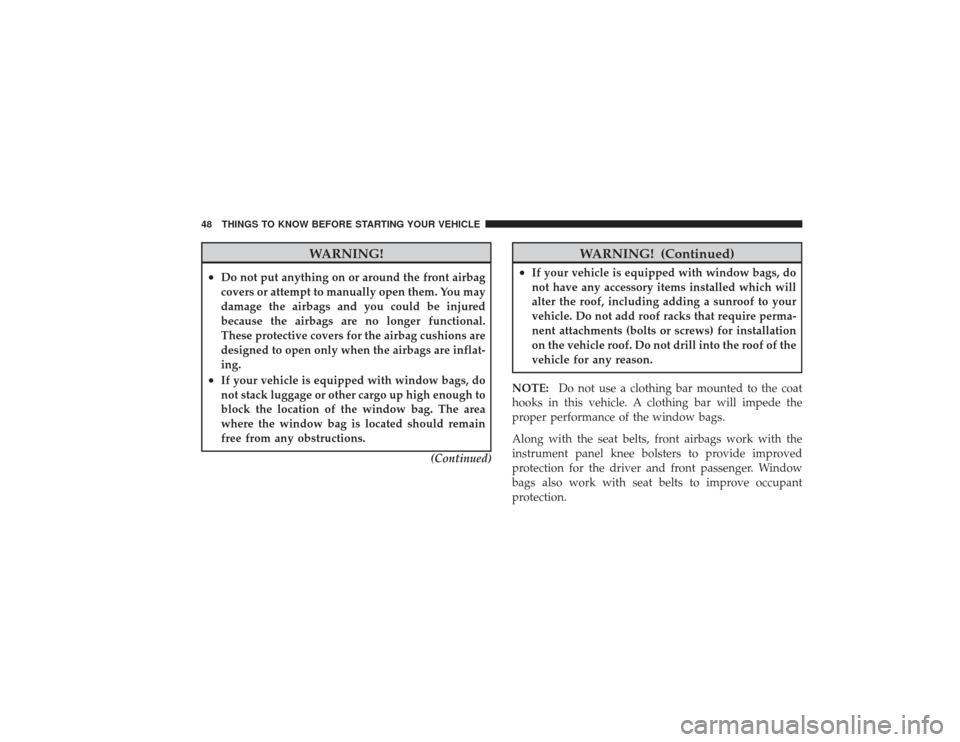
WARNING!
•
Do not put anything on or around the front airbag
covers or attempt to manually open them. You may
damage the airbags and you could be injured
because the airbags are no longer functional.
These protective covers for the airbag cushions are
designed to open only when the airbags are inflat-
ing.
•
If your vehicle is equipped with window bags, do
not stack luggage or other cargo up high enough to
block the location of the window bag. The area
where the window bag is located should remain
free from any obstructions.(Continued)
WARNING! (Continued)
•
If your vehicle is equipped with window bags, do
not have any accessory items installed which will
alter the roof, including adding a sunroof to your
vehicle. Do not add roof racks that require perma-
nent attachments (bolts or screws) for installation
on the vehicle roof. Do not drill into the roof of the
vehicle for any reason.
NOTE: Do not use a clothing bar mounted to the coat
hooks in this vehicle. A clothing bar will impede the
proper performance of the window bags.
Along with the seat belts, front airbags work with the
instrument panel knee bolsters to provide improved
protection for the driver and front passenger. Window
bags also work with seat belts to improve occupant
protection.
48 THINGS TO KNOW BEFORE STARTING YOUR VEHICLE
Page 51 of 532
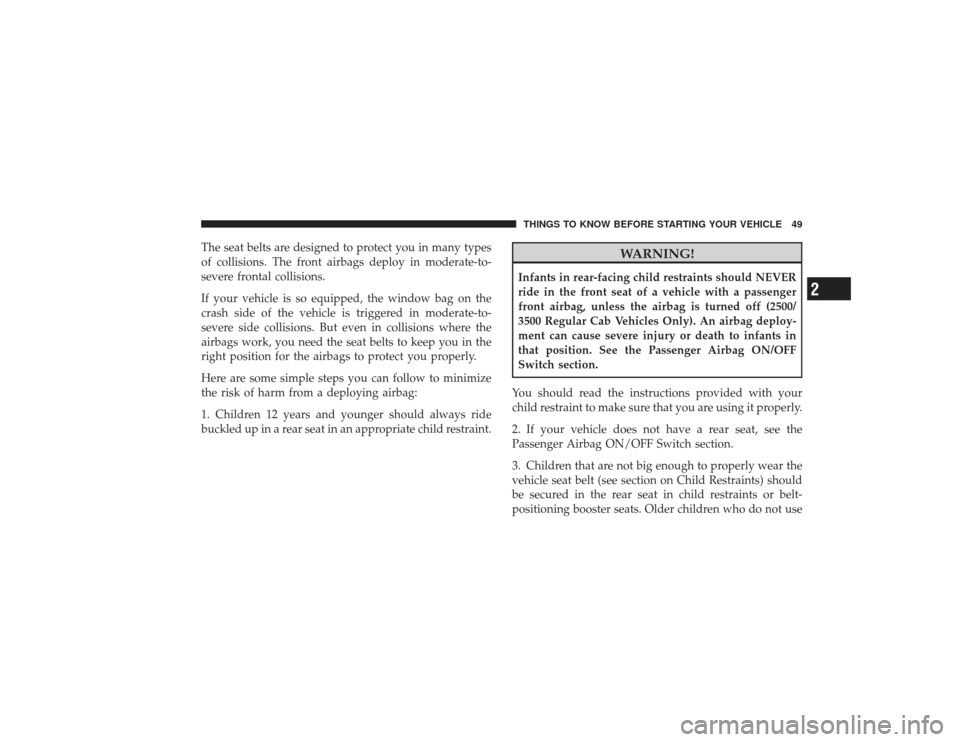
The seat belts are designed to protect you in many types
of collisions. The front airbags deploy in moderate-to-
severe frontal collisions.
If your vehicle is so equipped, the window bag on the
crash side of the vehicle is triggered in moderate-to-
severe side collisions. But even in collisions where the
airbags work, you need the seat belts to keep you in the
right position for the airbags to protect you properly.
Here are some simple steps you can follow to minimize
the risk of harm from a deploying airbag:
1. Children 12 years and younger should always ride
buckled up in a rear seat in an appropriate child restraint.
WARNING!
Infants in rear-facing child restraints should NEVER
ride in the front seat of a vehicle with a passenger
front airbag, unless the airbag is turned off (2500/
3500 Regular Cab Vehicles Only). An airbag deploy-
ment can cause severe injury or death to infants in
that position. See the Passenger Airbag ON/OFF
Switch section.
You should read the instructions provided with your
child restraint to make sure that you are using it properly.
2. If your vehicle does not have a rear seat, see the
Passenger Airbag ON/OFF Switch section.
3. Children that are not big enough to properly wear the
vehicle seat belt (see section on Child Restraints) should
be secured in the rear seat in child restraints or belt-
positioning booster seats. Older children who do not useTHINGS TO KNOW BEFORE STARTING YOUR VEHICLE 49
2
Page 52 of 532
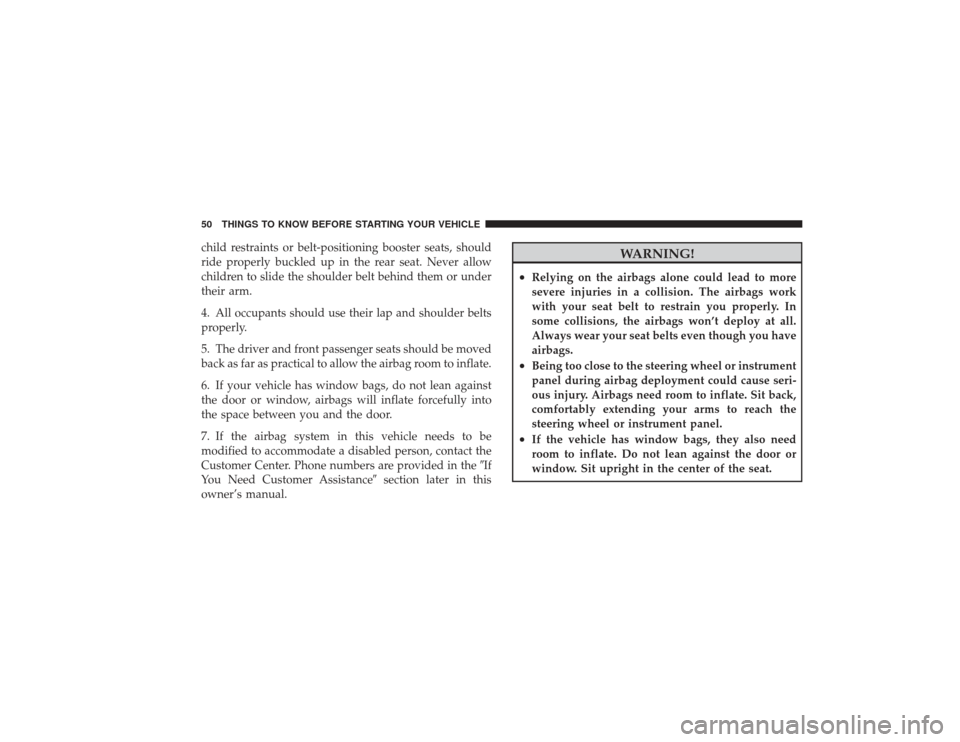
child restraints or belt-positioning booster seats, should
ride properly buckled up in the rear seat. Never allow
children to slide the shoulder belt behind them or under
their arm.
4. All occupants should use their lap and shoulder belts
properly.
5. The driver and front passenger seats should be moved
back as far as practical to allow the airbag room to inflate.
6. If your vehicle has window bags, do not lean against
the door or window, airbags will inflate forcefully into
the space between you and the door.
7. If the airbag system in this vehicle needs to be
modified to accommodate a disabled person, contact the
Customer Center. Phone numbers are provided in the�If
You Need Customer Assistance� section later in this
owner’s manual.
WARNING!
•
Relying on the airbags alone could lead to more
severe injuries in a collision. The airbags work
with your seat belt to restrain you properly. In
some collisions, the airbags won’t deploy at all.
Always wear your seat belts even though you have
airbags.
•
Being too close to the steering wheel or instrument
panel during airbag deployment could cause seri-
ous injury. Airbags need room to inflate. Sit back,
comfortably extending your arms to reach the
steering wheel or instrument panel.
•
If the vehicle has window bags, they also need
room to inflate. Do not lean against the door or
window. Sit upright in the center of the seat.
50 THINGS TO KNOW BEFORE STARTING YOUR VEHICLE
Page 53 of 532

Airbag System ComponentsThe airbag system consists of the following:•
Occupant Restraint Controller (ORC)
•
Side Remote Acceleration Sensors (if equipped)
•
Airbag Warning Light
•
Driver Airbag
•
Passenger Airbag
•
Window Bags above Side Windows (if equipped)
•
Steering Wheel and Column
•
Instrument Panel
•
Interconnecting Wiring
•
Knee Impact Bolsters
•
Front Acceleration Sensors (1500 Vehicles Only)
•
Driver and Front Passenger Seat Belt Pretensioners (if
equipped)
•
Driver Seat Track Position Sensor (if equipped)
•
Passenger Side Frontal Airbag ON/OFF Switch (2500/
3500 Regular Cab Vehicles Only)
•
Passenger Airbag Disable (PAD) Indicator Light
(2500/3500 Regular Cab Vehicles Only)
How the Airbag System Works
•
TheOccupant Restraint Controller (ORC) determines
if a frontal collision is severe enough to require the
airbags to inflate. The front airbag inflators are de-
signed to provide different rates of airbag inflation
from information provided by the ORC. The ORC will
not detect rollover or rear collisions.
The ORC also monitors the readiness of the electronic
parts of the system whenever the ignition switch is inTHINGS TO KNOW BEFORE STARTING YOUR VEHICLE 51
2
Page 55 of 532
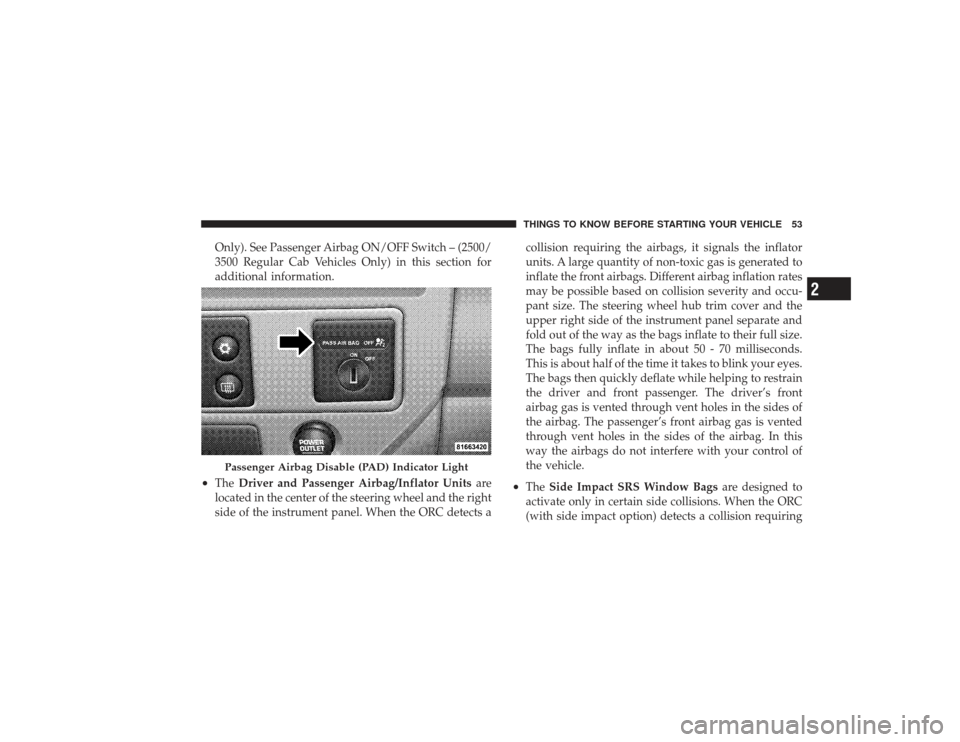
Only). See Passenger Airbag ON/OFF Switch – (2500/
3500 Regular Cab Vehicles Only) in this section for
additional information.
•
TheDriver and Passenger Airbag/Inflator Units are
located in the center of the steering wheel and the right
side of the instrument panel. When the ORC detects a collision requiring the airbags, it signals the inflator
units. A large quantity of non-toxic gas is generated to
inflate the front airbags. Different airbag inflation rates
may be possible based on collision severity and occu-
pant size. The steering wheel hub trim cover and the
upper right side of the instrument panel separate and
fold out of the way as the bags inflate to their full size.
The bags fully inflate in about 50 - 70 milliseconds.
This is about half of the time it takes to blink your eyes.
The bags then quickly deflate while helping to restrain
the driver and front passenger. The driver’s front
airbag gas is vented through vent holes in the sides of
the airbag. The passenger’s front airbag gas is vented
through vent holes in the sides of the airbag. In this
way the airbags do not interfere with your control of
the vehicle.
•
The
Side Impact SRS Window Bags are designed to
activate only in certain side collisions. When the ORC
(with side impact option) detects a collision requiring
Passenger Airbag Disable (PAD) Indicator Light
THINGS TO KNOW BEFORE STARTING YOUR VEHICLE 53
2
Page 56 of 532
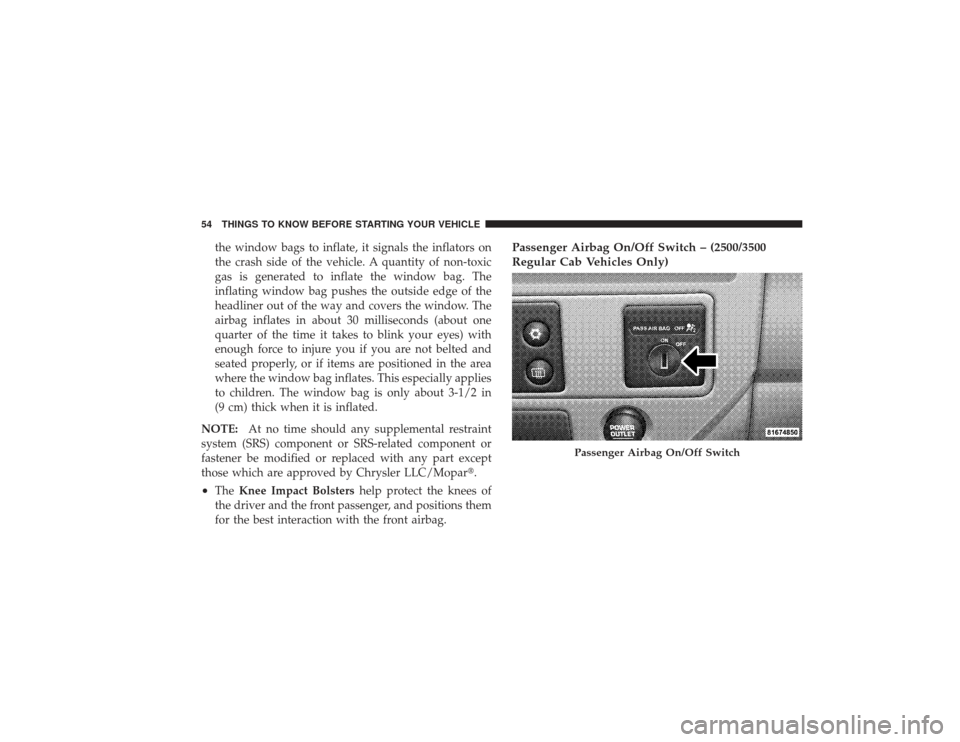
the window bags to inflate, it signals the inflators on
the crash side of the vehicle. A quantity of non-toxic
gas is generated to inflate the window bag. The
inflating window bag pushes the outside edge of the
headliner out of the way and covers the window. The
airbag inflates in about 30 milliseconds (about one
quarter of the time it takes to blink your eyes) with
enough force to injure you if you are not belted and
seated properly, or if items are positioned in the area
where the window bag inflates. This especially applies
to children. The window bag is only about 3-1/2 in
(9 cm) thick when it is inflated.
NOTE: At no time should any supplemental restraint
system (SRS) component or SRS-related component or
fastener be modified or replaced with any part except
those which are approved by Chrysler LLC/Mopar�.
•
The Knee Impact Bolsters help protect the knees of
the driver and the front passenger, and positions them
for the best interaction with the front airbag.
Passenger Airbag On/Off Switch – (2500/3500
Regular Cab Vehicles Only)
Passenger Airbag On/Off Switch
54 THINGS TO KNOW BEFORE STARTING YOUR VEHICLE
Page 77 of 532

If you are required to drive with the trunk/liftgate open,
make sure that all windows are closed and the climate
control BLOWER switch is set at high speed. DO NOT
use the recirculation mode.
The best protection against carbon monoxide entry into
the vehicle body is a properly maintained engine exhaust
system.
Whenever a change is noticed in the sound of the exhaust
system, when exhaust fumes can be detected inside the
vehicle, or when the underside or rear of the vehicle is
damaged, have a competent mechanic inspect the com-
plete exhaust system and adjacent body areas for broken,
damaged, deteriorated, or mispositioned parts. Open
seams or loose connections could permit exhaust fumes
to seep into the passenger compartment. In addition,
inspect the exhaust system each time the vehicle is raised
for lubrication or oil change. Replace as required.
Safety Checks You Should Make Inside the
Vehicle
Seat BeltsInspect the belt system periodically, checking for cuts,
frays, and loose parts. Damaged parts must be replaced
immediately. Do not disassemble or modify the system.
Front seat belt assemblies must be replaced after a
collision. Rear seat belt assemblies must be replaced after
a collision if they have been damaged (i.e., bent retractor,
torn webbing, etc.). If there is any question regarding belt
or retractor condition, replace the belt.Airbag Warning LightThe light should come on and remain on for six to eight
seconds as a bulb check when the ignition switch is first
turned ON. If the light is not lit during starting, see your
authorized dealer. If the light stays on, flickers, or comes
on while driving, have the system checked by an autho-
rized dealer.THINGS TO KNOW BEFORE STARTING YOUR VEHICLE 75
2